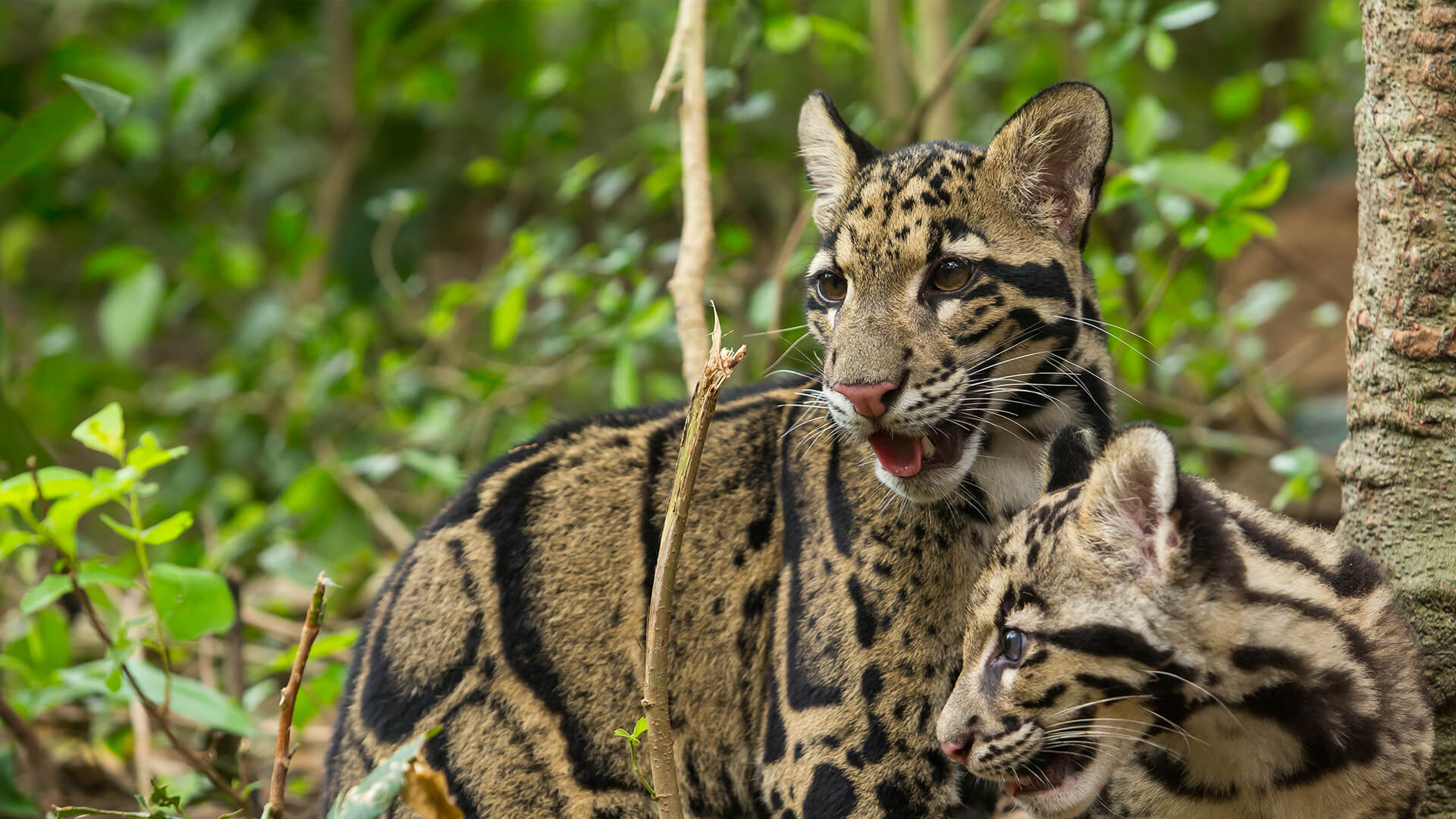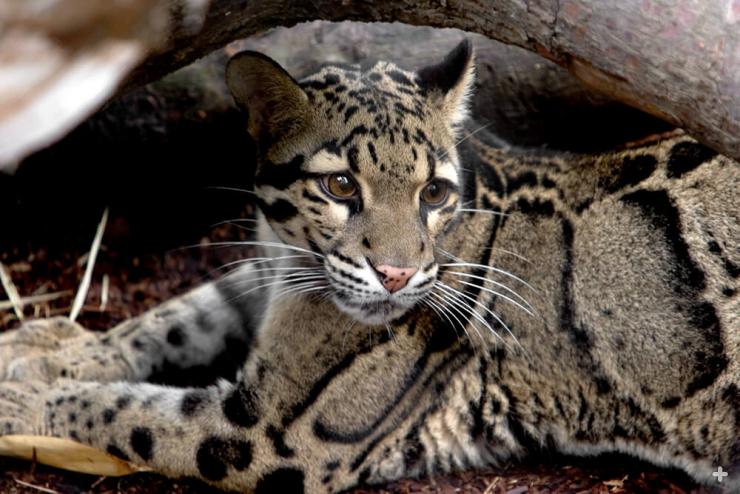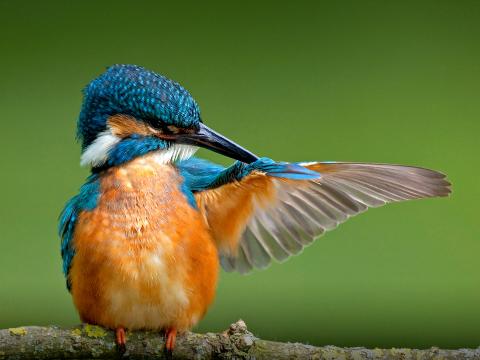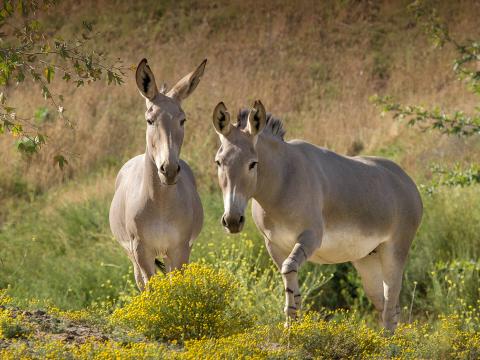Clouded Leopard
- Class: Mammalia (Mammals)
- Order: Carnivora
- Family: Felidae
- Subfamily: Pantherinae
- Genus: Neofelis
- Species: nebulosa (clouded leopard)
- Species: diardi (Sunda clouded leopard)
ABOUT
Cloudy taxonomy. Few people have seen a clouded leopard, either in its rainforest habitat in Southeast Asia or in a zoo. Officially recorded as a species in 1821, the clouded leopard remains just as mysterious today as it was nearly 200 years ago. Most of what we know about these cats comes from caring for them in zoos.
Named for its cloud-like spots, recent genetic studies have shown that clouded leopards are a separate genus of cat and not just a type of leopard. “Cloudeds” are most closely related to snow leopards and are now in the same taxonomic subfamily, Pantherinae, as tigers, lions, jaguars, and true leopards.
Interesting cats. They have a stocky build and are larger than small cats and smaller than the large cats! Male clouded leopards are generally twice the size of females. Cloudeds can purr like the small cats, but they also have a low, moaning roar, a soft chuffle, a growl, a hiss, and meows as part of their calls.
The pupils of the clouded leopard’s eyes are different from any other cat’s pupils: they never get fully round like a big cat’s pupils do, yet they never shrink to vertical slits like a small cat’s pupils do. Instead, they stay in an oblong shape. And then there’s that amazing tail—the longest, in relation to body size, of any cat's tail, which gives the clouded leopard great balance when strolling along tree branches.
A cat's life. Clouded leopards are typically rainforest dwellers but can be found in dryer forests as well in Southeast Asia. In areas where clouded leopards share their habitat with tigers and common leopards, cloudeds seem to be more nocturnal and arboreal in their habits to avoid competition for food. That long, thick tail provides balance in the trees, where the cats seek shelter and resting spots.
On islands or in other areas where there are no larger cats, clouded leopards are more active during the day and spend more time on the ground.
HABITAT AND DIET
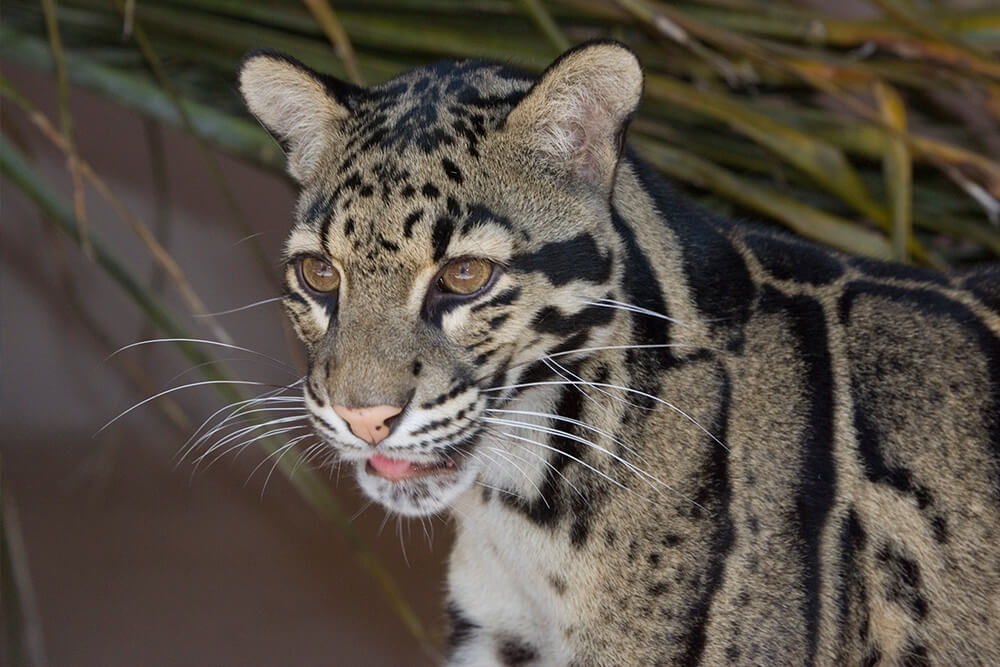
Home range. Clouded leopards live in Southeast Asia, mostly inhabiting tropical rainforest, but also journey into grassland, scrubland, and wetlands.
What big teeth you have! The clouded leopard really is a “big mouth.” It can open its jaws wider than any other cat, and its tooth development is most like that of the extinct sabertooth cat. A clouded’s 2-inch-long (5 centimeters) canine teeth are the same size as those of a tiger, even though a tiger is 10 times larger in body size!
A leg up on the competition. The clouded leopard has an advantage when it comes to hunting; its ankles can rotate backward so the cat can climb down a tree headfirst, climb upside down, and even hang from its back feet, leaving the powerful front paws free to snatch at prey. These cats can also ambush their prey from the treetops, landing on their target’s back and delivering one killing bite. Despite their small size, cloudeds can take down large hoofed animals with this method. However, it is believed they generally hunt on the ground and are thought to eat a variety of birds, squirrels, monkeys, and wild pigs.
Clouded leopards at the San Diego Zoo eat a fortified meat-based carnivore diet and gnaw on large beef knuckle bones. Sometimes they eat chunks of papaya frozen in ice blocks!
FAMILY LIFE
Caught in a bad romance. It is believed clouded leopards live solitary lives, unless a mother is caring for cubs. Breeding behavior has been documented only in managed-care facilities. Since adult male cloudeds are generally twice the size of females, the chance of injury to the female cat in a breeding encounter in managed care is always a concern, as males often kill their potential mates during courtship. It has been found that potential pairs that are introduced to each other at an early age have better breeding success.
Like any newborn kitten, clouded leopard cubs are small and helpless at birth. Their eyes are closed, they have no teeth, and they are not able to walk. But at about two weeks of age their eyes open, and a week later the teeth start to emerge, and they begin to walk on wobbly legs. Cubs begin solid food between 7 and 10 weeks of age but continue to nurse until 11 to 14 weeks old. By the time they are six months old, they are fully weaned and have the full adult coloration. This is when the mother most likely teaches her young to hunt. At 20 to 30 months old, they are ready to strike out on their own.
CONSERVATION
Secret cat. The clouded leopard is very secretive and has been difficult for scientists to study in their natural habitat, despite it being a good sized cat. Never common, its population numbers are dropping outside of protected areas. Its rainforest habitat is often divided into small, unconnected patches of forest by industrial logging and the development of agricultural areas, including vast palm oil plantations in Malaysia and Indonesia.
As is true of all rainforest dwellers, the clouded leopards’ main threat to survival is continued habitat loss from a growing number of farms. And although protected by law, the cat is still illegally hunted for its beautiful coat, and some cultures believe clouded leopard bones and teeth have healing powers, though this has been disproven.
New cats. Clouded leopards living on the Indonesian islands of Borneo and Sumatra were re-classified as a separate clouded leopard species in 2006: the Sunda or Diardi’s clouded leopard Neofelis diardi. This “new” species is a bit darker and has longer upper canines than the clouded leopards found on Asia’s mainland, Neofelis nebulosa. We still have much to learn about these fascinating felines!
Join us. San Diego Zoo Wildlife Alliance supports the Association of Zoos and Aquariums’ Species Survival Plan for clouded leopards. By supporting San Diego Zoo Wildlife Alliance, you are our ally in saving and protecting wildlife worldwide.

